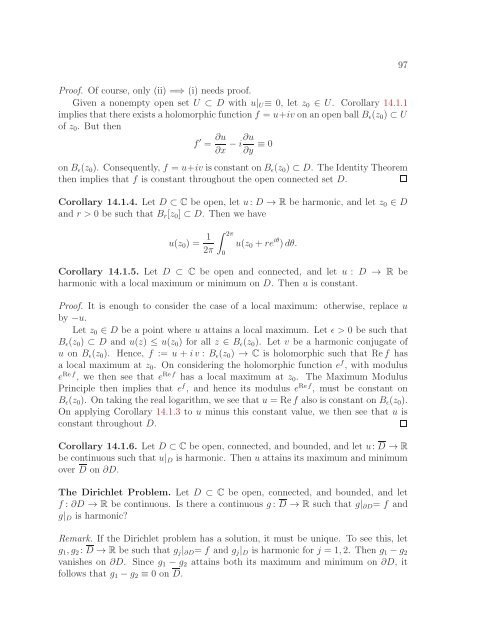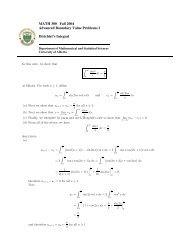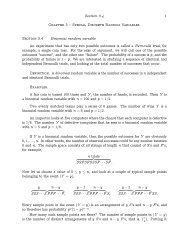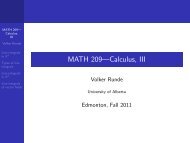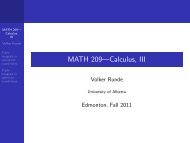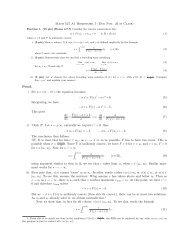Math 411: Honours Complex Variables - University of Alberta
Math 411: Honours Complex Variables - University of Alberta
Math 411: Honours Complex Variables - University of Alberta
Create successful ePaper yourself
Turn your PDF publications into a flip-book with our unique Google optimized e-Paper software.
Pro<strong>of</strong>. Of course, only (ii) =⇒ (i) needs pro<strong>of</strong>.<br />
Given a nonempty open set U ⊂ D with u|U≡ 0, let z0 ∈ U. Corollary 14.1.1<br />
implies thatthereexists aholomorphicfunction f = u+iv onanopenballBǫ(z0) ⊂ U<br />
<strong>of</strong> z0. But then<br />
f ′ = ∂u<br />
∂x −i∂u ≡ 0<br />
∂y<br />
onBǫ(z0). Consequently, f = u+iv isconstant onBǫ(z0) ⊂ D. TheIdentity Theorem<br />
then implies that f is constant throughout the open connected set D.<br />
Corollary 14.1.4. Let D ⊂ C be open, let u: D → R be harmonic, and let z0 ∈ D<br />
and r > 0 be such that Br[z0] ⊂ D. Then we have<br />
u(z0) = 1<br />
� 2π<br />
u(z0 +re<br />
2π 0<br />
iθ )dθ.<br />
Corollary 14.1.5. Let D ⊂ C be open and connected, and let u : D → R be<br />
harmonic with a local maximum or minimum on D. Then u is constant.<br />
Pro<strong>of</strong>. It is enough to consider the case <strong>of</strong> a local maximum: otherwise, replace u<br />
by −u.<br />
Let z0 ∈ D be a point where u attains a local maximum. Let ǫ > 0 be such that<br />
Bǫ(z0) ⊂ D and u(z) ≤ u(z0) for all z ∈ Bǫ(z0). Let v be a harmonic conjugate <strong>of</strong><br />
u on Bǫ(z0). Hence, f := u + iv : Bǫ(z0) → C is holomorphic such that Ref has<br />
a local maximum at z0. On considering the holomorphic function e f , with modulus<br />
e Ref , we then see that e Ref has a local maximum at z0. The Maximum Modulus<br />
Principle then implies that e f , and hence its modulus e Ref , must be constant on<br />
Bǫ(z0). On taking the real logarithm, we see that u = Ref also is constant on Bǫ(z0).<br />
On applying Corollary 14.1.3 to u minus this constant value, we then see that u is<br />
constant throughout D.<br />
Corollary 14.1.6. Let D ⊂ C be open, connected, and bounded, and let u: D → R<br />
be continuous such that u|D is harmonic. Then u attains its maximum and minimum<br />
over D on ∂D.<br />
The Dirichlet Problem. Let D ⊂ C be open, connected, and bounded, and let<br />
f : ∂D → R be continuous. Is there a continuous g: D → R such that g|∂D= f and<br />
g|D is harmonic?<br />
Remark. If the Dirichlet problem has a solution, it must be unique. To see this, let<br />
g1,g2: D → R be such that gj|∂D= f and gj|D is harmonic for j = 1,2. Then g1−g2<br />
vanishes on ∂D. Since g1 − g2 attains both its maximum and minimum on ∂D, it<br />
follows that g1 −g2 ≡ 0 on D.<br />
97


